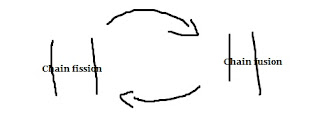Chain Fusion: Simplified EGs or TMs (element generators)
simple chain fusion no need for chain fission
Nuclear fusion produces new elements by "fusing" two small nuclei into a larger nucleus.
Explanation:
Nuclear fusion is a nuclear reaction in which two or more atomic
nuclei collide at nearly the speed of light and join to form a new type
of atomic nucleus. This creates new elements.
Nuclear fusion converts hydrogen into helium in all stars. For example,
₁¹H + ₁¹H → ₁²H + ₁⁰e
₁¹H + ₁²H → ₂³He
₁²H +₁³H → ₂⁴He + ₀¹n
Hydrogen and helium nuclei can then be fused into heavier elements. Gradually all the other elements up to uranium must have been formed in the stars.
Even heavier or “trans-uranium” elements can be made by accelerating two ions to very high speeds but in opposite directions and allowing them to collide. For example,
55
₉₂²³⁸U + ₇¹⁴N → ₉₉²⁴⁸Es + 4₀¹n
Other elements are made by neutron bombardment in a nuclear reactor. For example,
₉₄²³⁹Pu + 2₀¹n → ₉₅²⁴¹Am + ₋₁⁰e
So, from these two methods, a whole series of man-made or “artificial” elements from atomic number 93 to 118 have been synthesized.
Nuclear fusion converts hydrogen into helium in all stars. For example,
₁¹H + ₁¹H → ₁²H + ₁⁰e
₁¹H + ₁²H → ₂³He
₁²H +₁³H → ₂⁴He + ₀¹n
Hydrogen and helium nuclei can then be fused into heavier elements. Gradually all the other elements up to uranium must have been formed in the stars.
Even heavier or “trans-uranium” elements can be made by accelerating two ions to very high speeds but in opposite directions and allowing them to collide. For example,
55
₉₂²³⁸U + ₇¹⁴N → ₉₉²⁴⁸Es + 4₀¹n
Other elements are made by neutron bombardment in a nuclear reactor. For example,
₉₄²³⁹Pu + 2₀¹n → ₉₅²⁴¹Am + ₋₁⁰e
So, from these two methods, a whole series of man-made or “artificial” elements from atomic number 93 to 118 have been synthesized.




Comments
Post a Comment